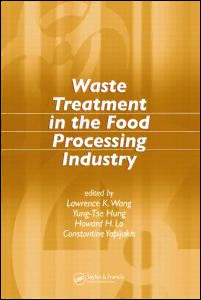
Waste Treatment in the Food Processing Industry PDF
Preview Waste Treatment in the Food Processing Industry
Waste Treatment in the Food Processing Industry Waste Treatment in the Food Processing Industry edited by Lawrence K. Wang Yung-Tse Hung Howard H. Lo Constantine Yapijakis Boca Raton London New York A CRC title, part of the Taylor & Francis imprint, a member of the Taylor & Francis Group, the academic division of T&F Informa plc. 7236_Discl.fm Page 1 Thursday, July 21, 2005 8:39 AM This material was previously published in the Handbook of Industrial and Hazardous Wastes Treatment, Second Edition ©Taylor and Francis Group, 2004. Published in 2006 by CRC Press Taylor & Francis Group 6000 Broken Sound Parkway NW, Suite 300 Boca Raton, FL 33487-2742 © 2006 by Taylor & Francis Group, LLC CRC Press is an imprint of Taylor & Francis Group No claim to original U.S. Government works Printed in the United States of America on acid-free paper 10 9 8 7 6 5 4 3 2 1 International Standard Book Number-10: 0-8493-7236-4 (Hardcover) International Standard Book Number-13: 978-0-8493-7236-0 (Hardcover) Library of Congress Card Number 2005049975 This book contains information obtained from authentic and highly regarded sources. Reprinted material is quoted with permission, and sources are indicated. A wide variety of references are listed. Reasonable efforts have been made to publish reliable data and information, but the author and the publisher cannot assume responsibility for the validity of all materials or for the consequences of their use. No part of this book may be reprinted, reproduced, transmitted, or utilized in any form by any electronic, mechanical, or other means, now known or hereafter invented, including photocopying, microfilming, and recording, or in any information storage or retrieval system, without written permission from the publishers. For permission to photocopy or use material electronically from this work, please access www.copyright.com (http://www.copyright.com/) or contact the Copyright Clearance Center, Inc. (CCC) 222 Rosewood Drive, Danvers, MA 01923, 978-750-8400. CCC is a not-for-profit organization that provides licenses and registration for a variety of users. For organizations that have been granted a photocopy license by the CCC, a separate system of payment has been arranged. Trademark Notice: Product or corporate names may be trademarks or registered trademarks, and are used only for identification and explanation without intent to infringe. Library of Congress Cataloging-in-Publication Data Waste treatment in the food processing industry / edited by Lawrence K. Wang … [et al.]. p. cm. Includes bibliographical references and index. ISBN 0-8493-7236-4 1. Food industry and trade--Waste disposal. I. Wang, Lawrence K. TD899.F585W37 2005 664'.0028'6--dc22 2005049975 Visit the Taylor & Francis Web site at http://www.taylorandfrancis.com Taylor & Francis Group and the CRC Press Web site at is the Academic Division of T&F Informa plc. http://www.crcpress.com Preface Environmentalmanagers,engineers,andscientistswhohavehadexperiencewithfoodindustry wastemanagementproblemshavenotedtheneedforabookthatiscomprehensiveinitsscope, directlyapplicabletodailywastemanagementproblemsoftheindustry,andwidelyacceptable by practicingenvironmental professionalsand educators. Manystandardindustrialwastetreatmenttextsadequatelycoverafewmajortechnologies forconventionalin-plantenvironmentalcontrolstrategiesinfoodindustry,butnoonebook,or seriesofbooks,focusesonnewdevelopmentsininnovativeandalternativetechnology,design criteria, effluent standards, managerial decision methodology, and regional and global environmental conservation. This book emphasizes in-depth presentation of environmental pollution sources, waste characteristics, control technologies, management strategies, facility innovations, process alternatives,costs,casehistories,effluentstandards,andfuturetrendsforthefoodindustry,and in-depth presentation of methodologies, technologies, alternatives, regional effects, and global effects of important pollution control practice that may be applied to the industry. This book covers new subjectsas much as possible. Importantwastetreatmenttopicscoveredinthisbookinclude:dairies,seafoodprocessing plants, olive oil manufacturing factories, potato processing installations, soft drink production plants,bakeriesandvariousotherfoodprocessingfacilities.Specialeffortsweremadetoinvite experts to contribute chapters in their own areas of expertise. Since the areas of food industry wastetreatmentisbroad,noonecanclaimtobeanexpertinallareas;collectivecontributions are better than a single author’s presentation for abook of thisnature. This book is one of the derivative books of the Handbook of Industrial and Hazardous WastesTreatment,andistobeusedasacollegetextbookaswellasareferencebookforthefood industry professional. It features the major food processing plants or installations that have significant effects on the environment. Professors, students, and researchers in environmental, civil, chemical, sanitary, mechanical, and public health engineering and science will find valuable educational materials here. The extensive bibliographies for each type of food waste treatmentorpracticeshouldbeinvaluabletoenvironmentalmanagersorresearcherswhoneed totrace, follow, duplicate, orimprove on aspecific food waste treatmentpractice. The intention of this book is to provide technical and economical information on the development of the most feasible total environmental control program that can benefit both foodindustryandlocalmunicipalities.Frequently,themosteconomicallyfeasiblemethodology iscombined industrial-municipal waste treatment. We are indebted to Dr. Mu Hao Sung Wang at the New York State Department of Environmental Conservation, Albany, New York, who co-edited the first edition of the v vi Preface Handbook of Industrial and Hazardous Wastes Treatment, and to Ms. Kathleen Hung Li at NEC Business Network Solutions, Irving, Texas, who is the Consulting Editor for this new book. Lawrence K. Wang Yung-TseHung HowardH. Lo ConstantineYapijakis Contents Preface v Contributors ix 1. Treatment ofDairy ProcessingWastewaters 1 Trevor J. Britz, Corne´ van Schalkwyk,and Yung-Tse Hung 2. Seafood Processing Wastewater Treatment 29 Joo-Hwa Tay,Kuan-Yeow Show, and Yung-TseHung 3. Treatment ofMeat Wastes 67 Charles J.Banksand ZhengjianWang 4. Treatment ofPalm Oil Wastewaters 101 Mohd Ali Hassan, ShahrakbahYacob,Yoshihito Shirai, andYung-Tse Hung 5. Olive Oil Waste Treatment 119 Adel Awad, Hana Salman, and Yung-TseHung 6. Potato Wastewater Treatment 193 Yung-Tse Hung,Howard H.Lo,Adel Awad, and Hana Salman 7. Soft Drink Waste Treatment 255 J. PaulChen, Swee-Song Seng, andYung-Tse Hung 8. Bakery Waste Treatment 271 J.Paul Chen, Lei Yang, Renbi Bai, and Yung-TseHung 9. Food Waste Treatment 291 Masao Ukita, TsuyoshiImai, andYung-Tse Hung Index 321 vii Contributors Adel Awad Tishreen University,Lattakia, Syria Renbi Bai National UniversityofSingapore, Singapore Charles J.Banks UniversityofSouthampton, Southampton,England Trevor J.Britz Universityof Stellenbosch, Matieland, South Africa J. PaulChen National Universityof Singapore, Singapore Mohd Ali Hassan UniversityPutraMalaysia, Serdang, Malaysia Yung-TseHung ClevelandStateUniversity,Cleveland,Ohio, U.S.A. TsuyoshiImai Yamaguchi University,Yamaguchi, Japan Howard H.Lo Cleveland State University, Cleveland,Ohio,U.S.A. Hana Salman Tishreen University, Lattakia, Syria Swee-SongSeng National University ofSingapore, Singapore YoshihitoShirai Kyushu Instituteof Technology, Kitakyushu, Japan Kuan-Yeow Show Nanyang Technological University,Singapore Joo-Hwa Tay NanyangTechnological University, Singapore Masao Ukita Yamaguchi University,Yamaguchi, Japan Corne´ van Schalkwyk UniversityofStellenbosch, Matieland, South Africa Zhengjian Wang University ofSouthampton, Southampton,England Shahrakbah Yacob UniversityPutra Malaysia,Serdang, Malaysia Lei Yang National Universityof Singapore, Singapore ix
